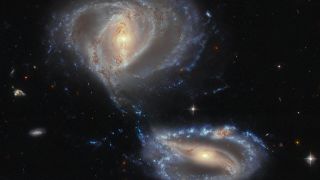Astronomers have long relied on the presence of carbon to trace a galaxy’s evolutionary journey. However, pinpointing these crucial “carbon fingerprints” within the faint light of distant galaxies has proven to be a laborious and inefficient task. Enter artificial intelligence (AI), poised to revolutionize our understanding of galactic evolution.
Carbon: A Signpost on the Cosmic Highway
The interstellar clouds that permeate distant galaxies are frequently teeming with carbon. Astronomers have dubbed these carbon-rich regions “neutral carbon absorbers,” and their presence serves as a valuable indicator of a galaxy’s evolutionary state. Galaxies that harbor these absorbers have likely undergone a period of rapid change, resulting in the production of elements heavier than hydrogen and helium – the primordial building blocks of the universe. Furthermore, the presence of carbon might signal the development of a galactic disk, akin to the majestic spiral arms of our Milky Way galaxy.

The Bottleneck: Sifting Through a Cosmic Haystack
Traditionally, astronomers have relied on painstaking manual analysis of spectral data – the unique fingerprint of light emitted by a galaxy – to detect these telltale signs of carbon. However, this method is incredibly time-consuming, especially when considering the vast expanse of the universe with its countless galaxies. The sheer volume of data has become overwhelming, hindering our ability to efficiently unlock the secrets encoded within.
AI to the Rescue: Unveiling Hidden Treasures
A team of researchers has successfully harnessed the power of AI, specifically a deep neural network, to revolutionize the detection of neutral carbon absorbers. Here’s how they achieved this breakthrough:
- Training the AI Eye: Neural networks learn by ingesting and analyzing data. In this case, the researchers recognized the limited availability of real-world data containing neutral carbon absorbers. To circumvent this obstacle, they created a vast dataset of 5 million simulated spectral patterns – essentially teaching the AI what to look for.
- Unleashing the AI on a Cosmic Dataset: Armed with its newfound knowledge, the trained neural network was set loose on spectral data collected by the Sloan Digital Sky Survey III, a monumental astronomical project that has mapped millions of celestial objects.
- A Treasure Trove of New Discoveries: The results were spectacular. The AI successfully identified neutral carbon absorbers in a staggering 107 galaxies – previously unknown to possess these telltale signatures. This represents a more than twofold increase in the number of known carbon-rich galaxies.
A Glimpse into the Early Universe
The newly discovered carbon-rich galaxies date back to an epoch approximately 10.8 billion years ago, a relatively early stage in the universe’s history. This discovery offers valuable insights into galactic formation processes during this crucial period. The presence of carbon in these ancient galaxies hints at the early development of galactic disks, structures that play a critical role in star formation and the evolution of galaxies over eons.
AI: Ushering in a New Era of Astronomical Discovery
Astronomy stands at the forefront of disciplines that generate enormous datasets. AI has emerged as an invaluable tool for analyzing these cosmic treasure troves, unearthing hidden patterns and secrets that might otherwise remain concealed to the human eye. This discovery of previously unknown carbon-rich galaxies is a testament to the transformative power of AI in astronomy. As we continue to refine our AI tools and expand our observational capabilities, we can expect a torrent of new discoveries that will reshape our understanding of the universe and our place within it.
The impact of AI extends far beyond simply identifying new galaxies. By automating the analysis of spectral data, AI frees up astronomers’ time, allowing them to delve deeper into the implications of these discoveries. They can focus on modeling



















